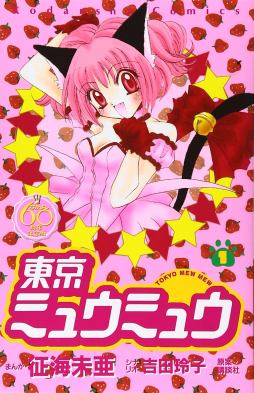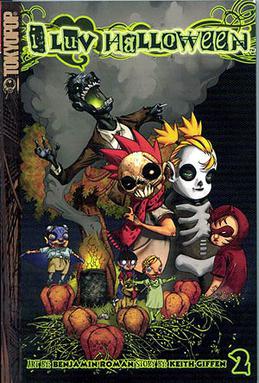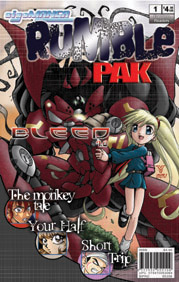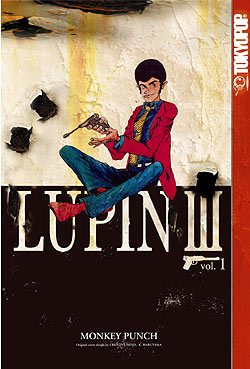
Manga are comics or graphic novels originating from Japan. Most manga conform to a style developed in Japan in the late 19th century, and the form has a long history in earlier Japanese art. The term manga is used in Japan to refer to both comics and cartooning. Outside of Japan, the word is typically used to refer to comics originally published in Japan and published in translation, i.e. a Japanese comic book with English text.

Megatokyo (メガトーキョー) is an English-language webcomic created by Fred Gallagher and Rodney Caston. Megatokyo debuted on August 14, 2000, and has been written and illustrated solely by Gallagher since June 17, 2002. Gallagher's style of writing and illustration is heavily influenced by Japanese manga. Megatokyo is freely available on its official website. The intended schedule for updates was for postings twice a week, but new comics are typically posted just once or twice a quarter on non-specific days. In 2011, updates began being delayed further due to the health issues of Sarah Gallagher (Seraphim), Gallagher's wife. Megatokyo was published in book-format by CMX, although the first three volumes were published by Dark Horse. For February 2005, sales of the comic's third printed volume were ranked third on BookScan's list of graphic novels sold in bookstores, then the best showing for an original English-language manga.

Love Hina is a Japanese manga series written and illustrated by Ken Akamatsu. It was serialized in Kodansha's Weekly Shōnen Magazine from October 1998 to October 2001, with the chapters collected into 14 tankōbon volumes by Kodansha. The series tells the story of Keitarō Urashima and his attempts to find the girl with whom he made a childhood promise to enter the University of Tokyo. The manga was licensed for an English-language release in North America and the United Kingdom by Tokyopop, in Australia by Madman Entertainment, and in Singapore by Chuang Yi. Two novelizations of Love Hina, written by two anime series screenwriters, were also released in Japan by Kodansha. Both novels were later released in North America and the United Kingdom by Tokyopop.

Magic Knight Rayearth is a Japanese manga series created by CLAMP. Appearing as a serial in the manga magazine Nakayoshi from the November 1993 issue to the February 1995 issue, the chapters of Magic Knight Rayearth were collected into three bound volumes by Kodansha. They were published from July 1994 to March 1995. A sequel was serialized in the same manga magazine from the March 1995 issue to the April 1996 issue. It was published by Kodansha in three bound volumes from July 1995 to April 1996.

Studio Ironcat was a small publishing company based in Fredericksburg, Virginia, dedicated to publication of manga and later, Amerimanga. The company is most known for its publication of the first volume of Megatokyo, a prominent webcomic, as well as the flamboyant style of one of its founders, Steve Bennett. The company was also known for regular turmoil within its wake, primarily during the years 2001–2003. One of these led to a period where the company did business under a different name as I.C. Entertainment.

Tokyopop is an American distributor, licensor and publisher of anime, manga, manhwa and Western manga-style works. The German publishing division produces German translations of licensed Japanese properties and original English-language manga, as well as original German-language manga. Tokyopop's US publishing division publishes works in English. Tokyopop has its US headquarters near Los Angeles International Airport in Los Angeles, California. Its parent company's offices are in Tokyo, Japan and its sister company's office is in Hamburg, Germany.

Rave Master, Rave, and alternatively, The Groove Adventure Rave in Japan, is a Japanese manga series written and illustrated by Hiro Mashima. The series follows Haru Glory, a teenager on a quest to find the five fragments of the sacred stone of light Rave in order to bring peace to the world by defeating the criminal group Demon Card. Mashima created this series with the idea of travelling around the world and was presented with difficulties in its serialization due to its considerable length.

Tokyo Mew Mew is a Japanese manga series created and written by Reiko Yoshida and illustrated by Mia Ikumi. It was originally serialized in Kodansha's shōjo manga magazine Nakayoshi from September 2000 to February 2003, with its chapters collected in seven tankōbon volumes by Kodansha. It focuses on five girls infused with the DNA of endangered animals which gives them special powers and allows them to transform into "Mew Mews". Led by Ichigo Momomiya, the girls protect Earth from aliens who wish to "reclaim" it.
Natsuki Takaya is a Japanese manga artist best known for creating the series Fruits Basket.

I Luv Halloween is a horror-comedy original English-language (OEL) manga written by Keith Giffen and illustrated by Benjamin Roman. In North America, Tokyopop released the series in three volumes from October 2005 to September 2007 and re-released it as one volume in October 2008. Menford Electronic Art also adapted it into animated short episodes which premiered on Myspace. Set on Halloween, the series focuses on a group of trick-or-treating children and their misadventures.
Manga, or comics, have appeared in translation in many different languages in different countries. France represents about 40% of the European comic market and in 2011, manga represented 40% of the comics being published in the country. In 2007, 70% of the comics sold in Germany were manga. In the United States, manga comprises a small industry, especially when compared to the inroads that Japanese animation or Japanese video games have made in the USA. One example of a manga publisher in the United States, VIZ Media, functions as the American affiliate of the Japanese publishers Shogakukan and Shueisha. Though the United Kingdom has fewer manga publishers than the U.S., most manga sold in the United Kingdom are published by U.S. publishing companies like Viz media and Kodansha Comics which are in turn owned by their Japanese counterparts. Alongside the United Kingdom, the U.S. manga publishers also sell their English translated manga in other English speaking nations like Canada, Australia and New Zealand with manga being quite popular in Australia compared to other English speaking countries.

Dramacon is an original English-language manga written and illustrated by Svetlana Chmakova. It was published in three volumes by Tokyopop from October 11, 2005 to December 11, 2007. Dramacon is considered one of Tokyopop's best OEL manga.
Svetlana Chmakova is a Russian-Canadian comic book artist. She is best known for Dramacon, an original English-language (OEL) manga spanning three volumes and published in North America by Tokyopop. Her other original work includes Nightschool and Awkward for Yen Press. She has been nominated for an Eisner Award twice. Previously, she created The Adventures of CG for CosmoGIRL! magazine and the webcomic Chasing Rainbows for Girlamatic.
Christy Lijewski is an American comic book artist and illustrator who specializes in OEL manga.

Kitchen Princess is a shōjo cooking, romance manga series written by Miyuki Kobayashi and illustrated by Natsumi Andō. Appearing as a serial in the manga magazine Nakayoshi from the September 2004 issue to the October 2008 issue, the forty-seven chapters were compiled into ten bound volumes by Kodansha, and published from February 2005 to November 2008. It also includes recipes for each featured dish at the end of each chapter. The series marked the first time that Ando illustrated a manga that was not also written by her. Set in modern-day Japan, Kitchen Princess follows Najika Kazami, a cheerful thirteen-year-old who searches for her "flan prince," a boy who rescued her from drowning as a young girl and brought a little happiness to her life after her parents' death. In March 2008, Kodansha published a related light novel, Kitchen Princess: Search for the Angel Cake, written by Kobayashi and illustrated by Ando.
A film comic or anime comic is a Japanese manga volume illustrated with images from an anime series, film, or video release, rather than original custom art. They generally contain the full dialog from the anime from which they are adapted. While usually published in book form, they are also sometimes released electronically as e-books, occasionally called e-manga. Companies such as Tokyopop and Viz release film comics under the trademarks Cine-manga and Ani-manga, respectively.

Rumble Pak is an Original English-language manga anthology series published by eigoMANGA. Rumble Pak showcases original comics created by artists from around the world including a line-up of original stories written and produced by predominantly independent American comics artists. Rumble Pak is eigoMANGA's first commercial comic book publication and is considered its flagship product. After its release, Rumble Pak rapidly became a recognized Amerimanga publication within the comic book industry.

Lupin III is a Japanese manga series written and illustrated by Monkey Punch. It follows the escapades of master thief Lupin III, the grandson of Arsène Lupin, the gentleman thief of Maurice Leblanc's series of novels.
Mary Alice "Marty" LeGrow, better known by her pen name M. Alice LeGrow, is an American alternative comics artist, best known for her gothic, dark fantasy graphic novel series Bizenghast.













